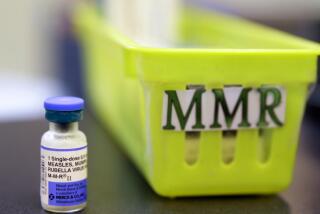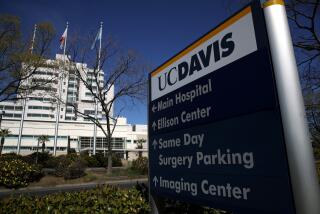California schools’ risks rise as vaccinations drop
A rising number of California parents are choosing to send their children to kindergarten without routine vaccinations, putting hundreds of elementary schools in the state at risk for outbreaks of childhood diseases eradicated in the U.S. years ago.
Exemptions from vaccines -- which allow children to enroll in public and private schools without state-mandated shots -- have more than doubled since 1997, according to a Times analysis of state data obtained last week.
The rise in unvaccinated children appears to be driven by affluent parents choosing not to immunize. Many do so because they fear the shots could trigger autism, a concern widely discredited in medical research.
But with autism rates rising, some parents find that fear more worrisome than the chance that their child could contract diseases that, while now very rare in this country, can still be deadly.
Last year, a 7-year-old boy triggered a measles outbreak in San Diego after he returned, infected, from a family trip to Switzerland. His parents had chosen not to vaccinate him or his siblings.
“The more children we have in our communities that are not immunized, the more likely we are going to have massive outbreaks,” said Dr. Gil Chavez, deputy director of the California Department of Public Health’s Center for Infectious Diseases.
In all, more than 10,000 kindergartners started school last fall with vaccine exemptions, up from about 8,300 the previous school year. In 1997, when enrollment was higher, the number of exempted kindergartners was 4,318.
Statewide, only 2% of kindergartners had exemptions. But The Times found they were enrolled in a relatively small number of schools. Parents who sign affidavits saying vaccines are “contrary to my beliefs” are most likely to send their children to schools in affluent areas -- many of them public charter schools and non-Catholic private schools.
The Times found that 1 in 11 elementary schools statewide may be at risk of an outbreak of an infectious disease such as measles, mumps or whooping cough. It’s a risk some parents are willing to take.
“As a parent, I’d rather deal with my kid dealing with measles or mumps and sit with them in a hospital . . . than taking your chances on a shot and having irreversible effects,” said Kim Hart, a mother of two in San Clemente.
In California, sending a child to school without all or some of the required shots is as simple as filling out a form, a policy that’s been in place for decades.
Parents’ fears grow
For generations, most children went unimmunized only if their parents couldn’t afford the shots, a problem now remedied through federal funds. A tiny percentage of children cannot be vaccinated for medical reasons.
But as parents’ fears about vaccine safety have grown, the demographics of the unvaccinated have shifted substantially. Although fewer than 2% of kindergartners at traditional public schools and Catholic schools in California had exemptions last fall, more than 4% of kindergartners at other private schools and nearly 10% of those enrolling in charter schools were exempted.
In south Orange County, 16 of the 38 elementary schools in the Capistrano Unified School District had high enough exemption rates to be at risk, as did nearly a quarter of the 26 elementary schools in the Saddleback Valley Unified School District.
A Times analysis found other concentrations on the Westside, the Palos Verdes Peninsula and the central Orange County coast, and in the southern San Fernando Valley.
At Ocean Charter School in Del Rey, near Marina del Rey, 40% of kindergartners entering school last fall and 58% entering the previous year were exempted from vaccines, the highest rates in the Los Angeles Unified School District.
Administrators at the school said the numbers did not surprise them. The nontraditional curriculum, they said, draws well-educated parents who tend to be skeptical of mainstream beliefs.
“They question traditional knowledge and feel empowered to make their own decisions for their families, not deferring to traditional wisdom,” said Assistant Director Kristy Mack-Fett.
Some parents at the school, which opened in 2004, said they struggled between what they believed was healthiest for their children and the risk that choice might create for others.
Kami Cotler, 44, delayed some vaccinations for her daughter, Callie Howard, 8. But by the time Callie went to school, she had received all of her shots.
“It seems like a social contract,” Cotler said on a recent morning at the school, where parents agree to ban TV on school nights and the children create their own textbooks. “If we all stop immunizing, that has serious ramifications as far as society is concerned.”
The risk to children is real, as the San Diego outbreak demonstrated.
In that case, a student at San Diego Cooperative Charter School contracted measles while traveling with his family in Switzerland, one of several European countries to see a resurgence of the disease. He then infected his two siblings and nine other children, including three infants too young to be fully vaccinated. Seventy other children were voluntarily quarantined for three weeks.
Public health officials said the virus spread quickly because an unusually large percentage of students at the boy’s school hadn’t been vaccinated. Nearly 10% of the 376 students at the campus had personal-belief exemptions for vaccines.
Last year the U.S. had at least 140 confirmed cases of measles, the highest number since 1996, 16 of them in California.
High-profile debate
The battle over vaccine safety has unfolded in the tabloids and on television. Jenny McCarthy, an actress and former Playboy model, has been outspoken in her beliefs that children are given too many vaccines too soon. McCarthy, whose son was diagnosed as autistic, is a main backer of the advocacy group Generation Rescue, and has said she has confirmed that vaccines cause autism.
Her views clash with those of actress Amanda Peet, a spokeswoman for Every Child by Two, which promotes early vaccinations. In a sign of how heated the debate can get, Peet recently apologized for calling parents who didn’t vaccinate their children “parasites.”
Last month, skeptics of vaccine safety faced a major setback when a special federal court ruledthat the measles-mumps-rubella vaccine and vaccines that contained a mercury-based preservative were not connected to the autism that developed in three children.
Public health experts say high rates of vaccination are crucial to the continued suppression of infectious diseases once rampant in the U.S.
If a high percentage of a group is vaccinated, even those who are not immunized are effectively protected by what is known as “herd immunity.” In practice, this means a child either too young to be fully vaccinated or unable to get vaccinations for medical reasons, such as allergies or a compromised immune system, would still be safe.
But the U.S. Centers for Disease Control and Prevention estimate that infections can spread quickly within a group when as few as 5% to 10% lack vaccination.
The Times, which analyzed data from the California Department of Public Health, considered any school with 7.5% or more of its kindergartners entering with vaccine exemptions to be at risk. In some cases, parents who filed exemptions may have chosen to vaccinate their children for some diseases but not others. Statewide, more than 430 schools had rates of 7.5% or higher and at least three unvaccinated kindergartners. The CDC says three cases of a disease such as measles are considered an outbreak.
The loss of confidence in vaccines is of great concern to public health experts, who worry that parents today have little experience of how devastating childhood diseases can be.
The trend at some California schools toward high rates of unimmunized children is at odds with record high immunization rates for children in the nation. A federal program in the early 1990s began funding inoculations for low-income children after the last major U.S. measles outbreak in 1989-91, which was spread largely by unvaccinated, low-income children who had no access to the inoculations.
The more people who are not vaccinated, the more likely diseases eradicated in the U.S. could make a comeback. A disease is considered eradicated if it cannot be spread widely even when it comes into the country through people who have traveled abroad.
England and Wales are already struggling to contain measles, which had been brought under control only to rise again as the vaccination rate dropped precipitously. The rate of immunization declined from 91% to 80% between 1998 and 2004.
Immunization rates began falling after a 1998 report in the British medical journal Lancet suggested a possible link between the vaccine for measles, mumps and rubella and autism -- a purported connection seized on by the British media.
Twenty subsequent studies have found no evidence that either the vaccine or the mercury-based preservative caused autism. And in 2004, the Lancet’s editors retracted the report after it was disclosed that the lead author, Andrew Wakefield, had received money from lawyers intending to sue vaccine manufacturers; an editor called the arrangement a “fatal conflict of interest.”
By then, measles had taken root. Last year, British public health authorities declared that measles was once again endemic. More than 1,300 measles cases in England and Wales were reported in 2008, the most in at least 15 years. Two measles patients have died since 2006. In California, some parents who have immunized their children expressed concern when told that their school had a significant percentage of students exempted from immunizations.
“Childhood diseases can kill,” said Steven C. Williams, who has a vaccinated 8-year-old son at Ocean Charter School. “For the other parents, I think that’s quite risky.”
At Truman Benedict Elementary School in the Capistrano district, 27% of the kindergarten class in 2007 and 8% of kindergartners last fall had a personal-belief exemption on file.
Corrie Melcher, whose two sons attend the school, said she hoped their vaccinations would keep them safe.
“But it is a concern that children could be bringing those types of diseases into the classroom,” she said.
Weighing options
Some parents who have chosen not to vaccinate, or agree to only some of the shots, said they did so after hearing about possible side-effects in the media, online and through other parents.
Julie Knights, a mother of three in San Clemente, said she gave her youngest, Cody, 5, only the shots she believed were absolutely necessary.
For example, she declined the vaccine for hepatitis B, a disease transmitted through infected blood or body fluids that can cause liver cancer and cirrhosis.
But Knights had Cody vaccinated for measles, mumps and rubella. She came to that decision after considering the possibility that her child could pass on rubella, also known as German measles, to a pregnant woman, resulting in brain damage or death to the unborn baby.
“I would feel socially responsible for that,” she said.
Other parents said they feared autism and side effects more than the diseases.
“Is it life-threatening to get the measles . . . or is he potentially going to get a life-threatening reaction by getting the vaccination?” asked Sarah Bjorklund. She vaccinated her two school-age children on schedule but delayed shots for her youngest son. “I think you have to weigh what is the benefit of the vaccination versus the risk.”
For Bjorklund -- whose children attend Stoneybrooke Christian Schools in San Juan Capistrano, where 18% of entering kindergartners had vaccine exemptions last fall -- doubts about vaccine safety resonate.
“Part of the reason is that there’s been such a huge rise in autism . . . and what’s the cause?” she said. “Just because the pharmaceutical companies say we need it doesn’t mean we need it.”
Public health experts say there is more than enough scientific proof that autism is not connected to vaccines and point out that many preventable childhood diseases can be deadly. Last year, a child whose parents had refused the vaccine for Hib, a type of bacteria, died in Minnesota, the first such death in that state since 1991. But they said it has been difficult to reassure skeptical parents.
“I think it’s hard to unscare people,” said Dr. Paul Offit, chief of infectious diseases at Children’s Hospital of Philadelphia and a co-inventor of the rotavirus vaccine.
sandra.poindexter @latimes.com
Times staff writer Doug Smith contributed to this report.
More to Read
Sign up for Essential California
The most important California stories and recommendations in your inbox every morning.
You may occasionally receive promotional content from the Los Angeles Times.











